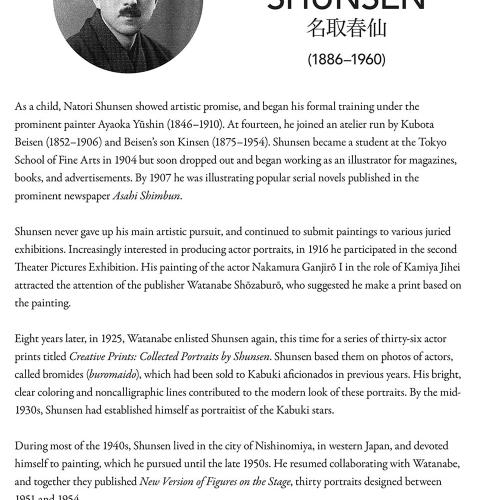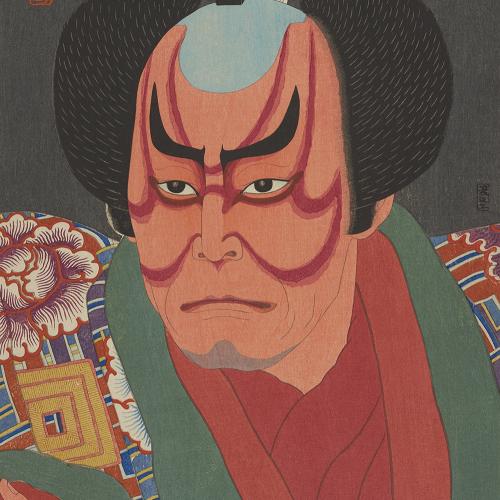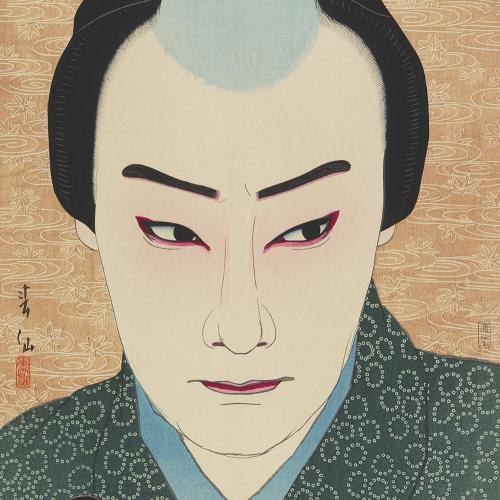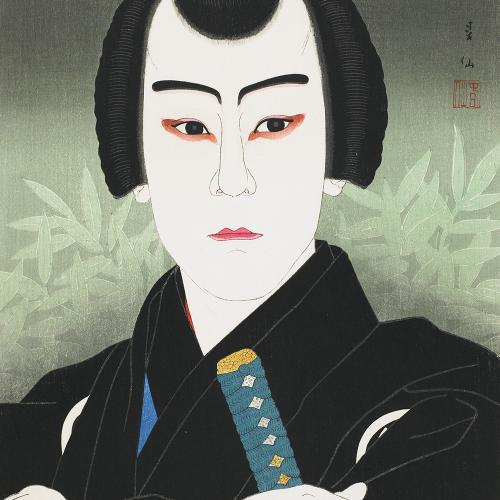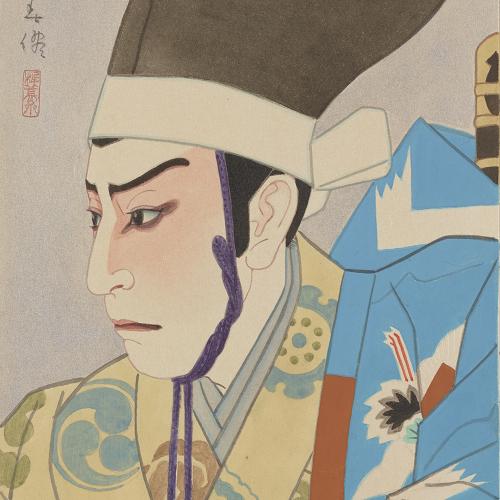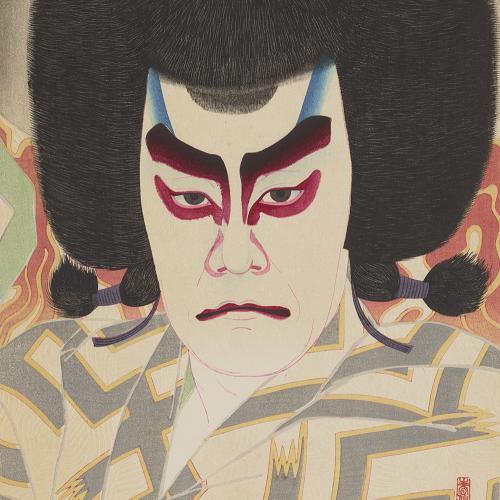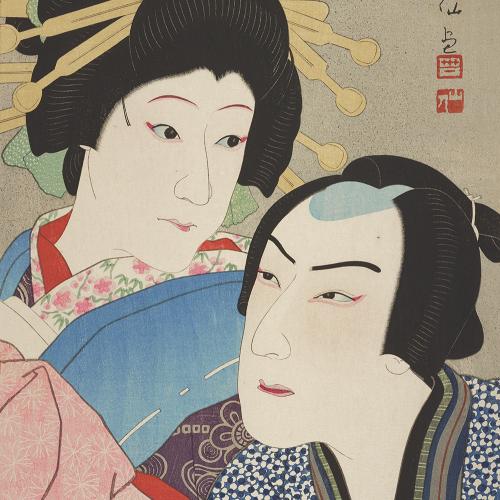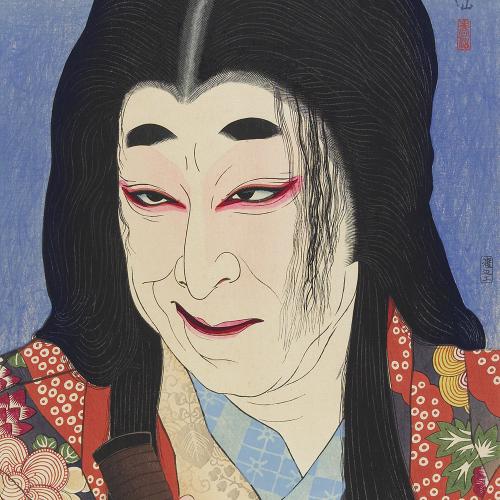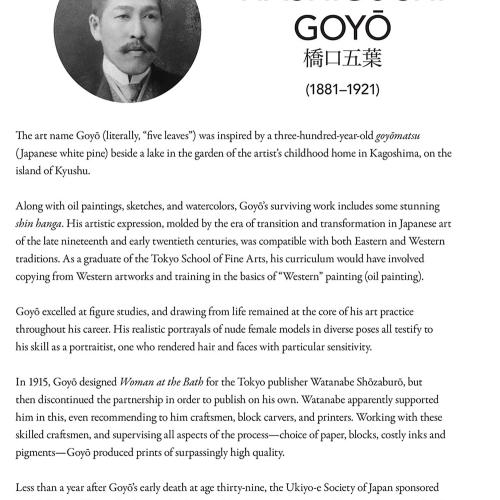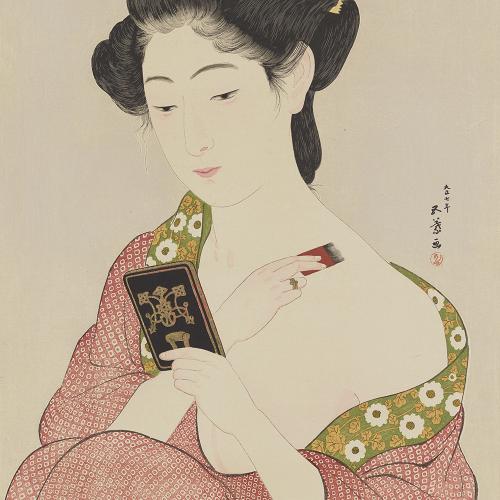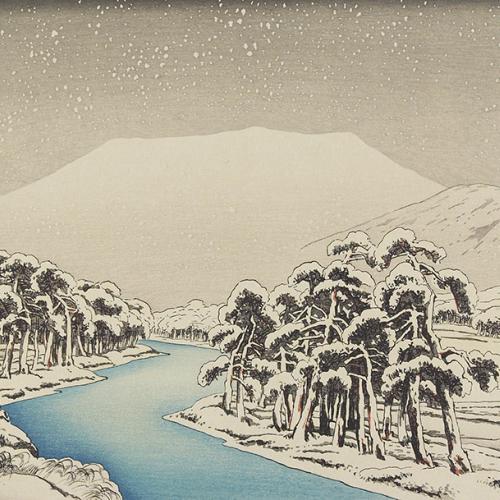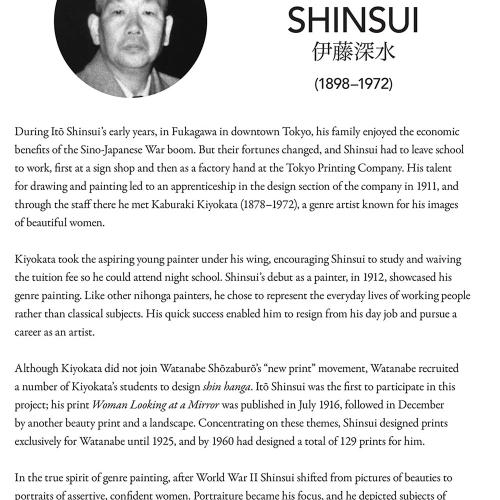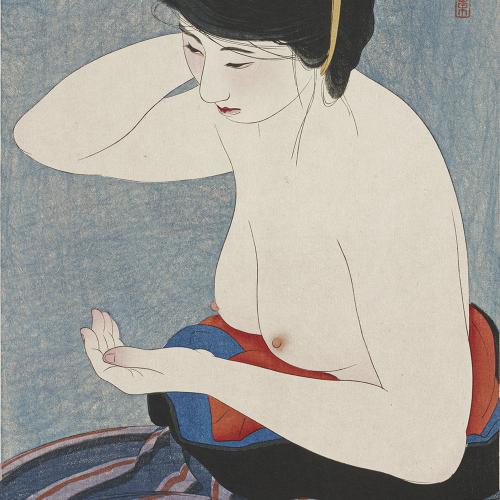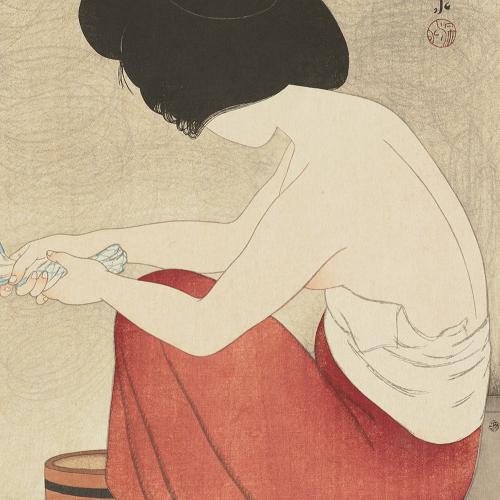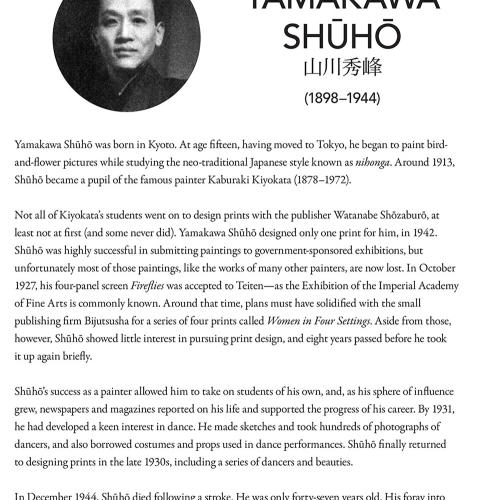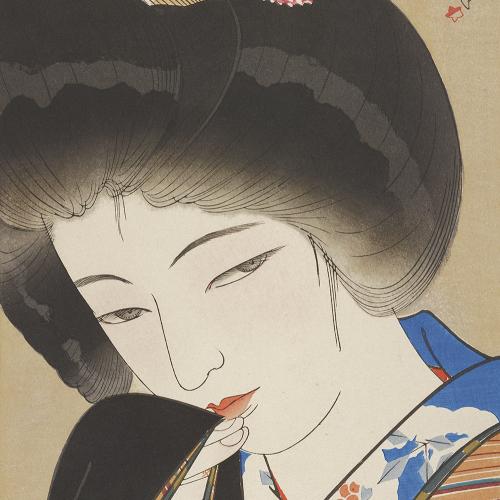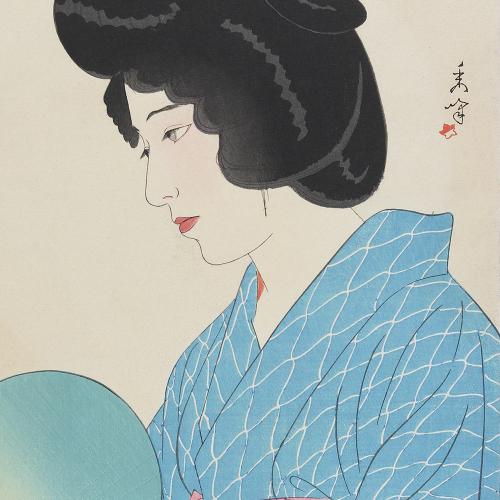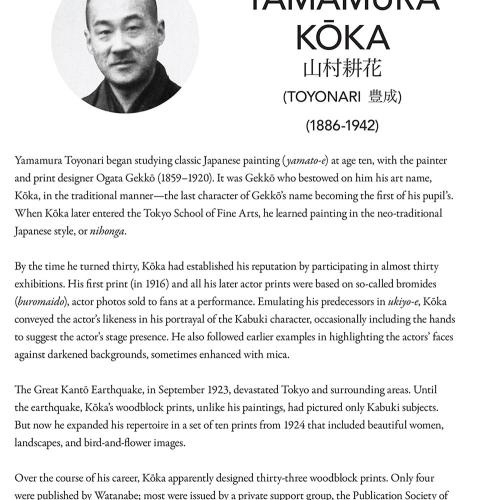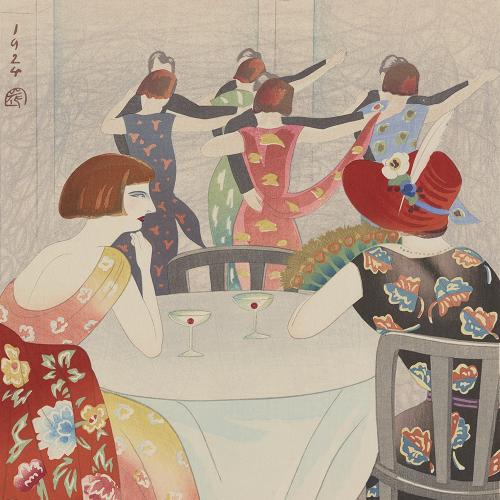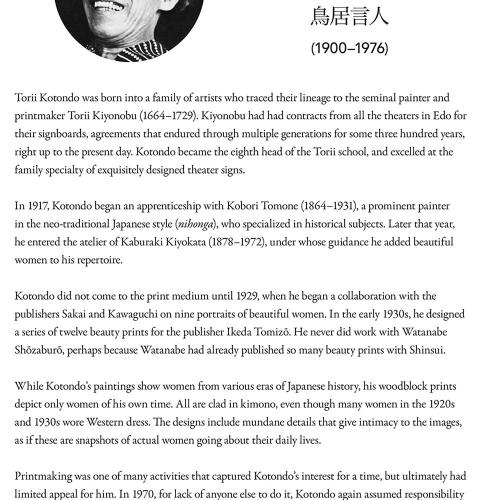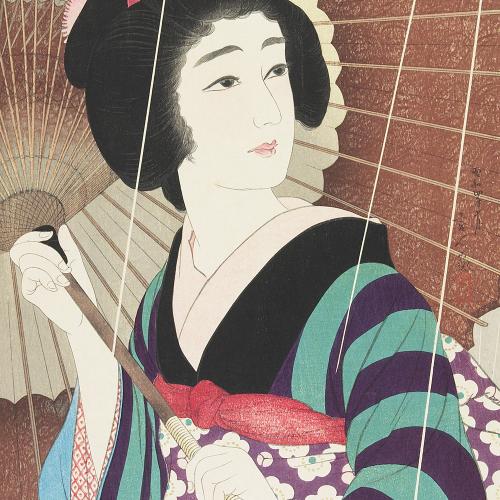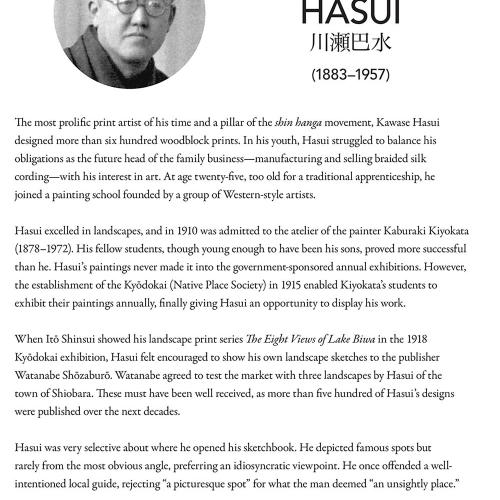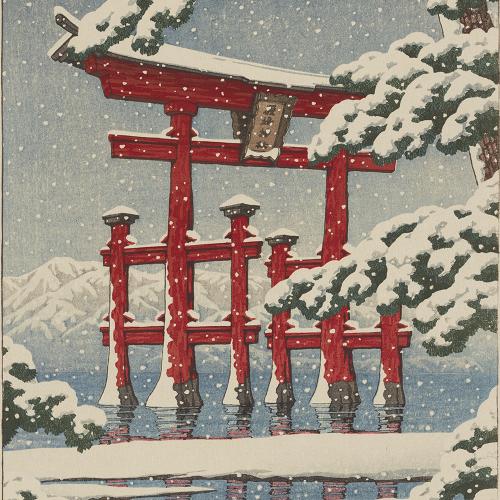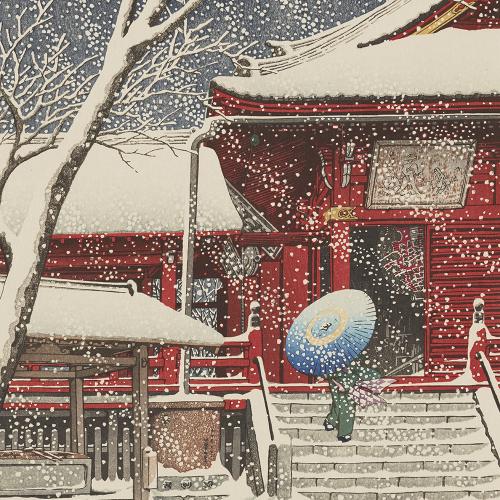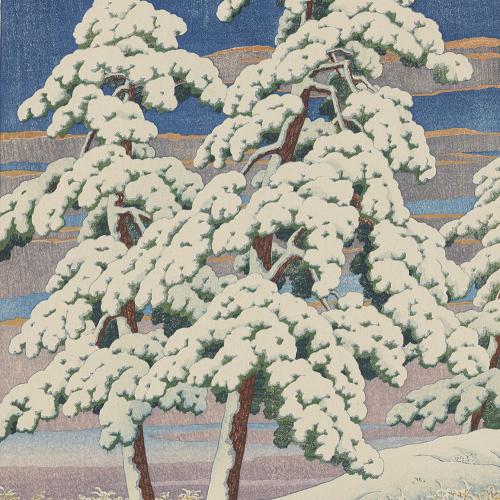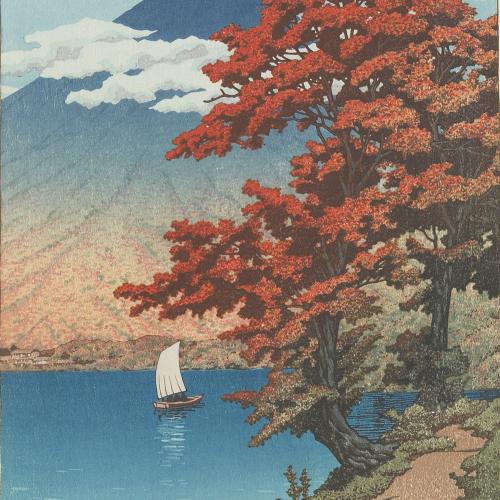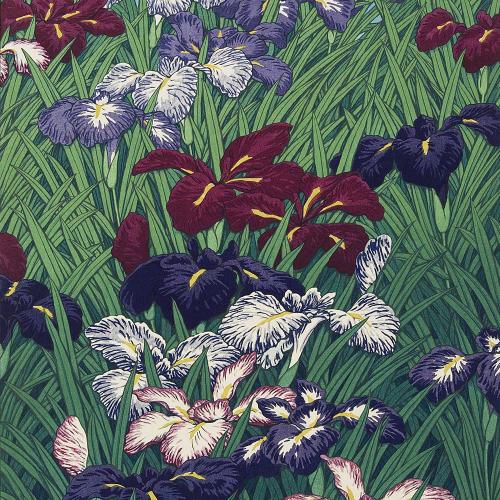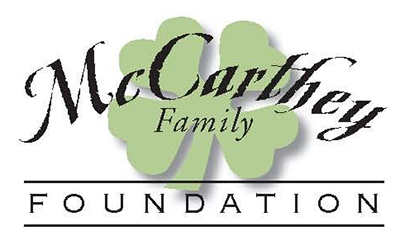
About Seven Masters
As the once-isolated nation of Japan entered the twentieth century and began to assimilate a new, Westernized culture, demand for certain traditional handicrafts fell off significantly—among them, the iconic woodblock prints known in the West as ukiyo-e. Publishers and artists slowed production and created fewer new designs. Yet what seemed at first to be the death-knell of a unique art form without parallel in the world turned out to be the dawning of another, as the path was cleared for a new kind of print: shin hanga.
Seven Masters: 20th-Century Japanese Woodblock Prints focuses on seven artists who played a significant role in the development of the new print, and whose works boldly exemplify this new movement. Drawing from the superb collection at the Minneapolis Institute of Art, the exhibition features the spectacular beauty portraits of the artists Hashiguchi Goyō (1880–1921), Itō Shinsui (1898–1972), Yamakawa Shūhō (1898–1944), and Torii Kotondo (1900–1976); striking images of kabuki actors by Yamamura Toyonari (Kōka; 1886–1942) and Natori Shunsen (1886–1960); as well as the evocative landscapes of Kawase Hasui (1883–1957). These multi-talented artists were all successful painters as well, but this exhibition looks exclusively at their unrivaled work in print design, and includes a cache of pencil drawings and rare printing proofs to offer insight into the exacting process of woodblock printing.
Explore a selection of prints from each artist in the galleries below:
Natori Shunsen, Japanese, 1886–1960
Natori Shunsen, Japanese, 1886–1960, The Actor Nakamura Kichiemon I as Otokonosuke, 1931, from the series Supplement to Collected Portraits by Shunsen, Woodblock print; ink and color on paper, published by Watanabe Shōzaburō, gift of Ellen and Fred Wells 2002.161.104, photo: Minneapolis Institute of Art
Nakamura Kichiemon I (1886–1954) is shown playing Arajishi Otokonosuke in Lespedeza, the Famous Tree of Sendai (Meiboku Sendai hagi) at the Kabuki Theater in October 1928. Otokonosuke stands below the floor of an inner room of the Ashikaga palace, guarding Tsurukiyo, the son of the feudal lord Yorikane. A large gray rat rushes by with a scroll in its mouth. Otokonosuke fails to kill it, and it escapes in a cloud of white smoke from which the villain Nikki Danjō appears with the scroll between his teeth. Otokonosuke is no match for Nikki Danjō’s magical powers.
Natori Shunsen, Japanese, 1886–1960, The Actor Nakamura Ganjirō I as Sakata Tōjūrō, 1925, From the series Creative Prints: Collected Portraits by Shunsen, Woodblock print; ink and color on paper, Published by Watanabe Shōzaburō, Gift of Ellen and Fred Wells 2002.161.59, Minneapolis Institute of Art
Nakamura Ganjirō I (1860–1935) is pictured here as Sakata Tōjūrō in the performance of Tōjūrō’s Love (Tōjūrō no koi) at the Shin-Tomi Theater in March and April 1921. He had filled the same role at the play’s premiere, in 1919. Tōjūrō is an actor preparing to play a seducer. He tests his acting skill on Okaji, the wife of a teahouse owner. Unaware that she is being exploited, Okaji is ashamed and commits suicide.
Natori Shunsen, Japanese, 1886–1960, The Actor Ichikawa Sumizō VI as Shirai Gonpachi, 1926, From the series Creative Prints: Collected Portraits by Shunsen, Woodblock print; ink and color on paper, Published by Watanabe Shōzaburō, Gift of Gary L. Gliem 2007.107.4, Minneapolis Institute of Art
This is the actor Ichikawa Sumizō VI (1886–1971) as Shirai Gonpachi in the “Suzugamori” scene of the play The Floating World's Pattern and Matching Lightning Bolts (Ukiyozuka hiyoku no inazuma), performed at the Asakusa Shōchiku Theater in January 1925. Gonpachi is a handsome villain who falls in love with a prostitute.
Natori Shunsen, Japanese, 1886–1960, The Actor Ichikawa Ebizō IX as Togashi Saemon in The Subscription List (Kanjinchō), March 1958, Watercolor study for a print; ink and color on paper with mica and embossing, Gift of funds from Ellen Wells 2014.68, Minneapolis Institute of Art
This watercolor study (never realized in print form) shows the actor Ichikawa Ebizō IX (1909–65) in an October 1957 performance of The Subscription List (Kanjinchō) at Tokyo’s Kabuki Theater, a production that later toured to Osaka and Nagoya. One of the most popular Kabuki plays, The Subscription List is set in the 12th century. Togashi, captain of the guard at the Ataka Gate, is charged with stopping the disguised Minamoto leader Yoshitsune, who tries to pass through the gate with some of his men.
Natori Shunsen, Japanese, 1886–1960, The Actor Ichikawa Sadanji II as Narukami, 1926, From the series Creative Prints: Collected Portraits by Shunsenm Woodblock print; ink and color on paper with mica and embossing, Published by Watanabe Shōzaburō, Gift of Ellen and Fred Wells X2004.2.11, Minneapolis Institute of Art
Ichikawa Sadanji II (1880–1940) appears here as the priest Narukami in the play Narukami, performed at the Imperial Theater in December of 1919.
A pious mountain priest with magical powers, Narukami has captured the dragon god in retribution for the emperor’s refusal to build him a temple. Because the dragon god is the source of rain, the country is now suffering from a drought, and Princess Taema is sent to trick Narukami into revealing how to free the captive god. But Narukami transforms (through a quick costume change on stage) into the furious thunder god.
Natori Shunsen, Japanese, 1886–1960, The Actors Ichikawa Shōchō II as Umegawa and Kataoka Gadō XII as Chūbei, 1927, From the series Creative Prints: Collected Portraits by Shunsen, Woodblock print; ink and color on paper, Published by Watanabe Shōzaburō, Gift of Ellen and Fred Wells 2002.161.109, Minneapolis Institute of Art
The actors Ichikawa Shōchō II (1886–1940) as Umegawa (on the left) and Kataoka Gadō XII (1882–1946) as Chūbei in the play A Message of Love from Yamato (Koi bikyaku Yamato orai). When Chūbei falls in love with the prostitute Umegawa, he embezzles public money entrusted to him to buy her way out of prostitution. The couple then decides to commit ritual suicide together before Chūbei can be arrested.
Natori Shunsen, Japanese, 1886–1960, The Actor Nakamura Utaemon V as Yodogimi, 1926, From the series Creative Prints: Collected Portraits by Shunsen, Woodblock print; ink and color on paper with embossing, Published by Watanabe Shōzaburō, Gift of Ellen and Fred Wells 2002.161.56, Minneapolis Institute of Art
The modern Kabuki play A Sinking Moon over the Lonely Castle Where the Cuckoo Cries (Hototogisu kojō no rakugetsu), by Tsubouchi Shōyō, premiered in 1905.
The role of Yodogimi was written especially for Nakamura Utaemon V (1865–1940), portrayed here as he performed it at the Kabuki Theater in June 1925. Yodogimi, widow of the famous warlord Toyotomi Hideyoshi, discovers a plot by Tokugawa Ieyasu to usurp her son’s power. She kills one of the conspirators and, increasingly paranoid, attacks Ieyasu’s granddaughter, her son’s betrothed.
Hashiguchi Goyō, Japanese, 1880–1921
Hashiguchi Goyō, Japanese, 1880–1921, Woman Applying Powder, 1918, Woodblock print; ink and color on paper with mica and embossing, self-published, carved by Takano Shichinosuke, printed by Somekawa Kanzō, gift of Ellen and Fred Wells 2002.161.206, Minneapolis Institute of Art
Goyō’s model, Nakatani Tsuru, is shown putting white powder on her shoulders with the aid of a small mirror. The background and hand mirror are embellished with mica. The robe’s tie-dye pattern (shibori) was achieved by blind printing.
Nakatani Tsuru is believed to have been the model for a number of erotic drawings by Goyō, some showing her with a male companion thought to be the artist himself.
Hashiguchi Goyō, Japanese, 1880–1921, Snow on Mount Ibuki, January 1920, Woodblock print; ink and color on paper, Distributed by Watanabe Shōzaburō, Carved by Takano Shichinosuke, Printed by Somekawa Kanzō, Gift of Ellen and Fred Wells 2002.161.43, Minneapolis Institute of Art
This print, though not published by Watanabe, was distributed by him for the Edo Pictures Appreciation Society. On the back is a note by Goyō explaining the origin of the design. In December 1919, he was coming home from Kobe on a train that had to stop because of mechanical problems. From the window, he saw this scenery.
An impression of this print fetched the highest price at the December 1925 auction of the American Art Association (predecessor of Sotheby’s) in New York: twenty dollars.
Itō Shinsui, Japanese, 1898–1972
Itō Shinsui, Japanese, 1898–1972, Applying Powder, spring 1922, from the series Twelve Forms of New Beauties, woodblock print; ink and color on paper, published by Watanabe Shōzaburō, gift of Ellen and Fred Wells, 2002.161.70, photo: Minneapolis Institute of Art
In the spring of 1922, Shinsui began designs for the first large-scale series of beautiful women with the publisher Watanabe: Twelve Forms of New Beauties. The plan was to issue editions of two hundred and release one print per month, starting in June. However, by May 1923 production was not finished. Shinsui designed the tenth beauty in June and the eleventh in July. The tremendous devastation of the Great Kantō Earthquake, on September 1, delayed things further, and the twelfth beauty did not come out until December.
Itō Shinsui, Japanese, 1898–1972, After the Bath, January 1917, woodblock print; ink and color on paper, published by Watanabe Shōzaburō, gift of Ellen and Fred Wells, 2002.161.162, photo: Minneapolis Institute of Art
Shinsui found that the shin hanga production system of employing a carver and a printer did not always allow him to pursue art on his own terms. Commenting on this work a few years after it was published, he wrote: “I made this design because Mr. Watanabe wanted it. Personally, I do not care much about it.”
Yamakawa Shūhō, Japanese, 1898–1944
Yamakawa Shūhō, Japanese, 1898–1944, Approaching Snow, December 1927, From the series Women in Four Settings, woodblock print; ink and color on paper, published by Bijutsusha, gift of Ellen and Fred Wells, 2002.161.55, photo: Minneapolis Institute of Art
In this extreme close-up of a young woman’s face, part of her traditional shimada-style coiffure is cropped off by the frame. The pattern of snow-covered nandina branches with red berries decorating her kimono, the pale gray background suggesting snow-laden clouds, and her sleeve-covered hand raised to protect against a chilly wind all proclaim the season to be winter.
Yamakawa Shūhō, Japanese, 1898–1944, Twilight, April 1928, from the series Women in Four Settings, woodblock print; ink and color on paper with mica and embossing, published by Bijutsusha, gift of Ellen and Fred Wells, 2002.161.69, photo: Minneapolis Institute of Art
The title Twilight refers to the time of day in summer when people went out to catch fireflies. This was traditionally done with a round, non-folding fan (uchiwa) like the one shown here. During Japan’s notoriously hot and humid summer months, blue was a popular color, visually conjuring coolness. The fishnet pattern on this woman’s pale blue kimono adds to the sense of freshness because of its association with water.
Yamamura Kōka (Toyonari), Japanese, 1886–1942
Yamamura Kōka (Toyonari), Japanese, 1886–1942, Dancing at the New Carlton Café in Shanghai, 1924, from an untitled set of ten prints, woodblock print; ink and color on paper with mica, published by Yamamura Kōka Hanga Kankōkai, gift of funds from Ellen Wells, 2014.35, photo: Minneapolis Institute of Art
This unusual view of a modern dance hall in booming, bustling Shanghai reflects the shifting interests and chic fashions of the Roaring Twenties in East Asia. A painting (whereabouts unknown) Kōka made earlier in the year depicted the same subject. These thoroughly modern women, wearing Western gowns and sporting bobbed hair, are an anomaly not only in Kōka’s work but in the entire shin hanga movement.
Torii Kotondo, Japanese, 1900–1976
Torii Kotondo, Japanese, 1900–1976, Rain, October 1929, Woodblock print; ink and color on paper, Published by Kawaguchi Jirō and Sakai Shōkichi, Gift of Ellen and Fred Wells 2002.161.20, Minneapolis Institute of Art
Kawase Hasui, Japanese, 1883–1957
Kawase Hasui, Japanese, 1883–1957, Snow at Miyajima Shrine, July 1929, woodblock print; ink and color on paper, published by Kawaguchi Jirō, carved by Maeda Kentarō, printed by Komatsu Wasankichi, gift of Paul Schweitzer, P.77.28.12, photo: Minneapolis Institute of Art
Kawase Hasui, Japanese, 1883–1957, Snow at Kiyomizu Hall in Ueno, July 1929, woodblock print; ink and color on paper, published by Kawaguchi Jirō, carved by Maeda Kentarō, printed by Komatsu Wasankichi, gift of Paul Schweitzer, P.77.28.10, photo: Minneapolis Institute of Art
Kawase Hasui, Japanese, 1883–1957, Pine Tree in Clear Weather after Snow, August 1929, woodblock print; ink and color on paper, published by Kawaguchi Jirō and Sakai Shōkichi, carved by Maeda Kentarō, printed by Komatsu Wasankichi, gift of Paul Schweitzer, P.77.28.14, photo: Minneapolis Institute of Art
Kawase Hasui, Japanese, 1883–1957, Lake Chūzenji at Nikkō, 1930, woodblock print; ink and color on paper, published by Kawaguchi Jirō, carved by Maeda Kentarō, printed by Komatsu Wasankichi, gift of Paul Schweitzer, P.77.28.17, photo: Minneapolis Institute of Art
Kawase Hasui, Japanese, 1883–1957, Irises, July 1929, woodblock print; ink and color on paper, published by Kawaguchi Jirō, gift of Ellen and Fred Wells, 2002.161.134, photo: Minneapolis Institute of Art
Seven Masters is curated by Andreas Marks, head of the Japanese and Korean Art Department at the Minneapolis Institute of Art.
Seven Masters is supported locally by presenting sponsor George S. and Dolores Doré Eccles Foundation, conservation sponsor McCarthey Family Foundation, and programming sponsor Gift in Memory of Hayden H. Huston. With additional support from the University of Utah Asia Center.
The UMFA also presents Beyond the Divide: Merchant, Artist, Samurai in Edo Japan, an exhibition of scrolls, screens, sculpture, prints, and samurai armor and weapons from the Museum’s own collection of Japanese art, on view in a major presentation for the first time in more than a decade. Beyond the Divide, organized by UMFA associate curator of collections and antiquities Luke Kelly, also opens February 6 and is on view through Sunday, July 5, 2020.
Below you can watch a virtual tour of Beyond the Divide and Seven Masters, led by curator Luke Kelly.
Seven Masters: 20th-Century Japanese Woodblock Prints was organized by the Minneapolis Institute of Art and is toured by International Arts & Artists, Washington, D.C.

| Presenting Sponsor: | Conservation Sponsor: | Programming Sponsor: | Additional Support: |
 |
|
Gift in Memory of Hayden H. Huston |
Anne K. Stewart Docent Conservation Fund |
Thank you for visiting the UMFA online. We hope you have enjoyed this content. Community support makes all of the work we do possible, including this type of virtual experience. If you wish to see more offerings like this, and ensure the future of the Museum, please consider making a donation today.
We wish you, your family, and loved ones the very best during these difficult times.
Thank you!

